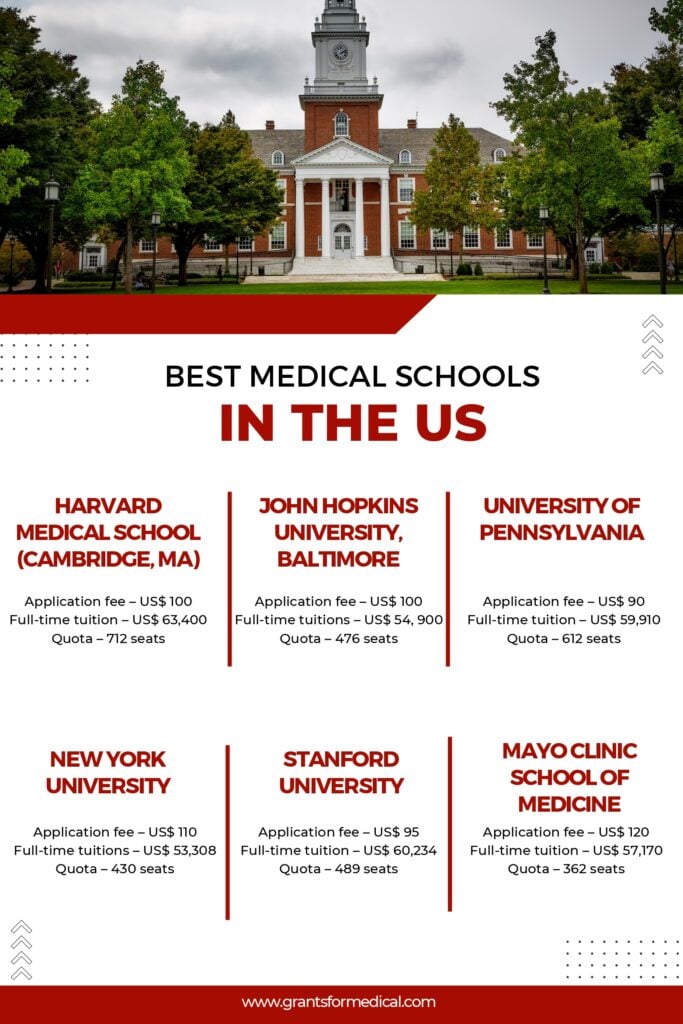Medical education is a dynamic field, with different schools offering unique approaches and programs to train the next generation of healthcare professionals. From Duke University's structured curriculum to Yale's emphasis on research, each institution has its own strengths. In this article, we will explore some of the top medical schools in the United States, their distinctive features, and the factors that contribute to their high rankings. Whether you're interested in primary care or cutting-edge research, there's a medical school out there to help you achieve your goals. So let's dive in and discover the exciting world of medical education!
Duke University
The approach to medical education at Duke University differs from that of other institutions. Instead of the traditional four-year program, Duke offers a unique and structured curriculum. The breakdown of the medical course at Duke University School of Medicine is as follows:
#1. Year One: Foundational Sciences
#2. Year Two: Clinical Rotations
#3. Year Three: Scholarly Research
#4. Year Four: Clinical Electives
Students with a passion for medical research have the opportunity to complete the program and join the team of clinical researchers at an accelerated pace. Duke University is renowned for its status as the world's largest clinical research academic organization. Their team of expert researchers is dedicated to advancing the field of medicine by conducting phase I to phase IV trials on a range of unidentified diseases. With over 100,000 registered patients, the research team is able to efficiently carry out testing and research phases on those involved.
University of Washington School of Medicine
Founded in 1946, the University of Washington School of Medicine has been the leading provider of medical education in the Washington, Alaska, Idaho, Montana, and Wyoming region. To ensure accessibility, the university has established a network that spans over 100 cities in these five states. This network provides a fixed and limited number of students with comprehensive medical education.
The curriculum of this network follows a three-semester structure per year, allowing students to complete their medical education in a timely manner. The university's primary goal is to produce more doctors for primary care across various medical centers in these states. As a result, the school has gained a reputation as one of the most esteemed institutions for primary medical care education, serving hundreds of students annually.
Yale School of Medicine
The Yale School of Medicine is a highly ranked medical research institute in the United States that is known for its extensive range of resources. At the heart of these resources is the school's impressive library, which offers comprehensive access to educational materials and information spanning numerous subjects.
Originally established in 1810 as the Medical Institution of Yale College, the school adopted its current name in 1918. The Yale School of Medicine offers education in various medical fields, including biomedical science, medicine, and public health.
The education program at Yale University follows a unique structure. During the first two years of medical education, students are not given ranks or grades, and examinations are limited. Instead, students are encouraged to independently research different subjects. The basic medical course lasts four years, with an additional year dedicated to in-depth research for those seeking further study. Alongside the standard programs, the school offers various specialized programs to cater to students' interests.
University of Pittsburgh School of Medicine
The University of Pittsburgh School of Medicine is renowned for its efficient and rapid medical education programs. From the first year, the university provides students with vital clinical experiences. Through these experiences, students develop their interpersonal skills and medical expertise by conducting patient interviews in community healthcare settings.
Additionally, the first and second-year students spend a few hours each week gaining practical experience in medical facilities and hospitals. A longitudinal research project is a mandatory requirement for all students during their four-year medical degree. The university places a strong emphasis on practical knowledge and skill development, prioritizing them over written examinations. This approach allows students to gain extensive knowledge and experience in their chosen field.
Northwestern University Feinberg School of Medicine
Similar to the University of Pittsburgh School of Medicine, grading at the Northwestern University Feinberg School of Medicine differs for the first two years compared to the third and fourth years. During the first two years, students are evaluated based on a pass or fail system without receiving specific grades. However, in the third and fourth years, students are graded on a scale ranging from fail to high pass and honor grades.
To encourage further engagement and knowledge acquisition, students at Northwestern University Feinberg School of Medicine are given three afternoons each week to participate in extracurricular activities. These activities provide opportunities for students to delve deeper into subjects and engage in various research projects.
Due to the unique grading system, students at the school experience less pressure and can focus more on practical applications, making them exceptionally skilled medical providers. The emphasis is placed on delivering quality care to patients rather than solely aiming for high rankings.
Icahn School of Medicine at Mount Sinai
Emory University
University of Chicago (Pritzker)
University of Michigan
Baylor College of Medicine
The Case Western Reserve University
University of North Carolina
The University of Texas Southwestern Medical Center
University of Colorado
University of Southern California
University of Maryland
Ohio State University
University of Virginia
Boston University
Oregon Health and Science University
Vanderbilt University School of Medicine (Nashville, TN)
Vanderbilt University, located in Nashville, Tennessee, is a highly esteemed institution. With its extensive campus spanning 340 acres, it holds the distinction of being the largest university in the state. The university comprises 10 schools, four of which offer undergraduate programs.The school of medicine is affiliated with the Vanderbilt Health Affiliated Network, which includes 60 hospitals and 5,000 clinicians. This network makes Vanderbilt University one of the largest academic medical centers in the United States.
Vanderbilt University's medical center provides students with hands-on experience and exposure to real-world scenarios. Students have access to state-of-the-art equipment and learn practical skills through various medical departments.
University of Nebraska Medical Center (Omaha, Nebraska)
The University of Nebraska Medical Center, located in Omaha, Nebraska, is the largest medical center in the state. The university prides itself on being inclusive and welcoming students from all communities, including international students pursuing a career in the medical field.
To expand educational opportunities beyond the medical field, the university has recently constructed a new building dedicated to engineering, information technology, and various other fields. This commitment to affordable education demonstrates the university's dedication to providing comprehensive programs beyond medicine.
The University of Nebraska offers 19 different programs for medical students to choose from, granting 391 doctorate degrees in various fields of medical science.
University of New Mexico School of Medicine (Albuquerque, New Mexico)
The University of New Mexico School of Medicine has played a significant role in improving healthcare infrastructure since its establishment in 1964. As a result, it has earned a reputation as one of the top universities in the medical field. The school places a strong emphasis on rural health training and family medicine.
With a remarkable acceptance rate of 97%, the university offers quick admission to students seeking a medical education. It is an inclusive institution that welcomes both local and international students, providing equal facilities and education opportunities for all.
The university offers bachelor's, master's, and doctorate degrees, as well as various other programs to help students pursue their careers in their desired fields. With over 40 different programs available, the University of New Mexico School of Medicine presents a wealth of options for medical students.
University of Connecticut Medical School (Storrs, Connecticut)
The University of Connecticut runs a School of Medicine dedicated to providing affordable and cutting-edge education in the medical field. The university's mission encompasses innovation, education, discovery, and service, all of which are shared across different departments to guide students towards successful futures.
International students are welcomed at the university, where they receive equal facilities and education opportunities. The range of programs available includes bachelor's, master's, and doctorate degrees with high acceptance rates. For medical students, there are 67 programs offered at the University of Connecticut.
School of Medicine University of Utah (Salt Lake City, Utah)
Located on the upper side of the Salt Lake City campus, the School of Medicine at the University of Utah boasts an impressive acceptance rate of 95%, making it one of the easiest universities in the United States to gain admission to. It is the sole medical school in Utah granting MD degrees.
The university provides a wide range of educational programs at both the bachelor's and master's levels, along with numerous doctorate programs. With a total of 64 medical programs available, the University of Utah boasts one of the largest medical schools in the US.
Indiana University School of Medicine (Indianapolis City, Indiana)
Indiana University School of Medicine, one of the largest universities in the United States, offers a comprehensive medical education through its 20 clinical departments and five basic science departments. The school is renowned for providing high-level education to students pursuing medical degrees.
The school employs an advanced education system that delves into the depths of various subjects, with a particular focus on improving the healthcare environment through modern curriculum activities.
Miller School of Medicine University of Miami (Miami, Florida)
The Miller School of Medicine at the University of Miami is committed to producing highly skilled doctors who can serve the global community. The school not only prioritizes education but also emphasizes research, development, and scientific advancements. Within the university's enriching environment, medical students have ample opportunities to pursue diverse careers.
The university invites students from around the world to pursue their medical degrees in various fields. The Miller School of Medicine offers an array of programs to cater to the individual career goals of medical students.
UC Davis School of Medicine University of California (Sacramento, California)
The UC Davis School of Medicine has received numerous accolades for its commitment to healthcare education, earning it the top spot in the nation for primary care. Student-centric education is at the heart of the institution, providing high-quality programs that train future doctors and healthcare professionals.
The school offers a wide range of programs that equip students with the skills and knowledge necessary to excel in their medical careers. UC Davis School of Medicine offers an impressive 66 programs for medical students to choose from.
Carver College of Medicine University of Iowa Healthcare (Iowa City, Iowa)
The University of Iowa Healthcare runs the Carver College of Medicine, which provides medical education to individuals pursuing a doctorate degree in the state of Iowa. The college has earned a reputation as one of the best medical schools in the nation, according to U.S. News.
The University of Iowa Healthcare is dedicated to healthcare education, research, patient care, and the overall improvement of the healthcare infrastructure. It offers hundreds of programs across various fields, including bachelor's, master's, and doctorate degrees. For medical students, there are 86 different programs available at the University of Iowa.
College of Medicine University of Arizona (Tucson, Arizona)
The College of Medicine at the University of Arizona provides innovative undergraduate education to aspiring medical students. The university welcomes students from all corners of the globe, providing them with a platform to build successful careers in the medical field. Students can participate in various research programs to gain practical experience during their time at the university.
The university offers numerous programs for bachelor's, master's, and doctorate degrees, catering to the specific requirements of medical students. With 89 doctorate programs available, the University of Arizona is a comprehensive hub for medical students.
Highlights of the College of Medicine University of Arizona
#1. Admission Fee:
#2. Full-time Tuition Fee: $11,299 (in-district students), $35,821 (out-of-state students)
#3. Quota: 1,010 seats
US News updates methodology after criticism
In response to criticism, U.S. News has revised its methodology for ranking medical schools. Several prominent institutions, including Harvard University, Columbia University, the University of Pennsylvania, the Icahn School of Medicine at Mount Sinai, and Stanford University, have opted out of participating in U.S. News' annual rankings.
Katrina Armstrong, dean of Columbia's Valegos College of Physicians and Surgeons, expressed concerns that the rankings perpetuate a narrow and elitist perspective on medical education. In an attempt to address these concerns, U.S. News has introduced new ranking criteria for this year's medical school rankings. This includes evaluating faculty resources, academic achievements of incoming students, and research productivity. While schools that opted out did not provide data, U.S. News utilized publicly available information to fill in any gaps.
Methodology for the research rankings
For research rankings, U.S. News assesses schools based on a weighted average of various indicators:
- Research activity: Total federal research activity, research activity per faculty member, total NIH research grants, and average NIH research grants per faculty.
- Qualitative assessment: Peer assessment score from medical school deans, deans of academic affairs, and residency directors.
- Student selectivity: Median MCAT score, median undergraduate GPA, and acceptance rate.
- Faculty resources: Ratio of full-time faculty to full-time MD or DO students.
The top 10 medical schools for research
According to U.S. News, the top 10 medical schools for research are as follows:
1. Harvard University*
2. Johns Hopkins University
3. University of Pennsylvania*
4. Columbia University*
5. Duke University*
5. Stanford University*
5. University of California, San Francisco
5. Vanderbilt University
5. Washington University in St. Louis*
10. Cornell University*
10. New York University
10. Yale University
*Indicates schools that did not participate in this year's survey and data from the prior year was used instead.
Methodology for the primary care rankings
For primary care rankings, U.S. News assesses schools based on a weighted average of the following indicators:
- Primary care productivity: Number of medical school graduates practicing in primary care specialties and the percentage of graduates entering primary care residencies.
- Qualitative assessment: Peer assessment score from medical school deans, deans of academic affairs, and residency directors.
- Student selectivity: Median MCAT score, median undergraduate GPA, and acceptance rate.
- Faculty resources: Ratio of full-time faculty to full-time MD or DO students.
The top 10 medical schools for primary care
The top 10 medical schools for primary care, according to U.S. News, are as follows:
1. Washington University
2. University of Minnesota
3. Oregon Health and Science University
4. University of New Mexico
5. University of California, San Francisco
6. University of California, Davis
7. University of North Carolina, Chapel Hill
8. University of Colorado
8. University of Nebraska Medical Center
10. University of California, Los Angeles
What's the Difference Between a Primary Care and a Research Medical School?
Gone are the days when medical schools solely focused on training physicians for clinical practice. Nowadays, medical schools offer multifaceted programs that extend beyond traditional medical education. In addition to primary care, schools often provide opportunities for students to pursue additional degrees, such as a PhD or a master's in business administration or law. Specialized programs, including public health and nursing, are also incorporated into many medical schools' comprehensive educational frameworks.
While most medical schools offer primary care education, gaining admission to a research-focused medical school may be more competitive. Nevertheless, if you have a strong scientific interest in advanced medicine, technology, or development, attending a top medical school with a robust research program may be the ideal choice.
Research-focused schools often receive significant external funding to support their programs, as reflected in their rankings.
What Factors Contribute to a Medical School's High Ranking?
Top ranking services like U.S. News evaluate medical schools based on a variety of factors, including quality and peer assessments, student admission standards and acceptance rates, average GPA and MCAT scores, faculty qualifications and resources, tuition costs, graduation rates, external funding, faculty accomplishments, and ongoing studies.
In recent years, diversity and inclusivity have become increasingly important factors in a school's overall ranking. Medical schools strive to foster a more representative student body, considering race and gender in their rankings to ensure the field of healthcare encompasses a broad range of perspectives.

In conclusion, choosing the right medical school is a crucial decision that can shape your entire career in the field of medicine. With a vast array of options available, it's important to consider various factors, such as curriculum structure, research opportunities, faculty resources, and the overall educational environment. Whether you're interested in primary care or cutting-edge research, there's a medical school out there that can provide the perfect balance for your interests and goals. Take the time to explore your options, visit campuses, and speak with current students to find the best fit for your future in medicine. Remember, the journey to becoming a skilled and compassionate healthcare provider starts with choosing the right institution.





